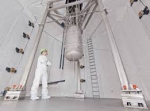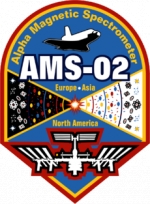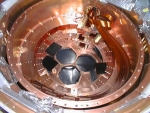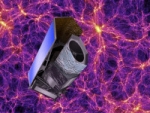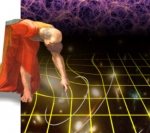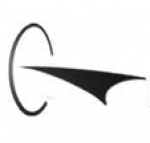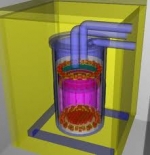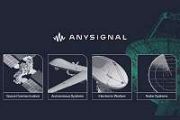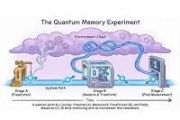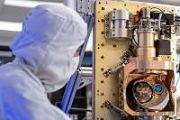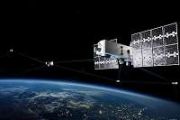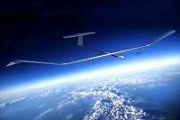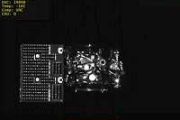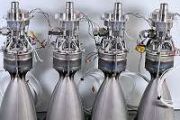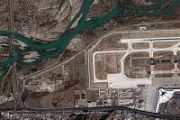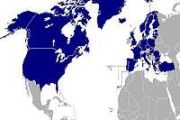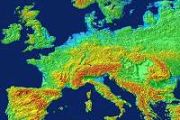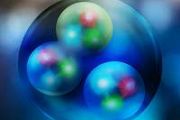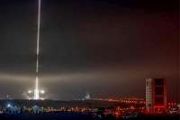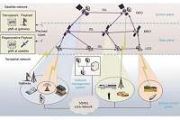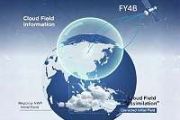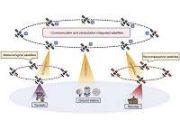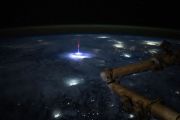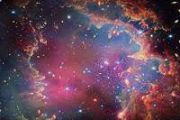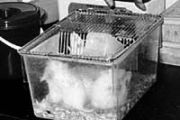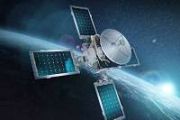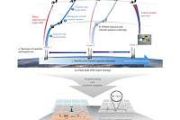Displaying items by tag: dark matter
LUX dark matter detector
The Large Underground Xenon Detector (LUX) is a 370 kg liquid xenon physics experiment that aims to directly detect interactions between Weakly Interacting Massive Particle (WIMP) dark matter and ordinary matter on Earth.
Despite the wealth of evidence supporting the existence of non-baryonic dark matter in the Universe, dark matter in our galaxy has never been directly detected on Earth. The LUX experiment utilizes a large detector mass in a time-projection chamber (TPC) configuration to identify individual particle interactions in the liquid xenon volume, which will allow it to look for faint dark matter interactions with unprecedented sensitivity.
The LUX experiment is located 4,850 ft (about 1 mile) underground at the Sanford Underground Research Facility (formerly the Deep Underground Science and Engineering Laboratory) in Lead, South Dakota. Underground, the detector is located in the Davis campus, the former site of the Nobel-prize winning Homestake neutrino experiment led by Raymond Davis. The LUX experiment needs to be operated underground in order to reduce signal background caused by high-energy cosmic rays at the Earth's surface.
The LUX experimental collaboration is composed of more than 100 scientists and engineers across 18 institutions in the US and Europe.
The detector assembly began in late 2009. The fully assembled detector was transported from the surface laboratory to the underground space in a two-day operation in the summer of 2012.
Alpha Magnetic Spectrometer - AMS
The Alpha Magnetic Spectrometer, also designated AMS-02, is a particle physics experiment module that is mounted on the International Space Station.
It is designed to measure antimatter in cosmic rays and search for evidence of dark matter. This information is needed to understand the formation of the Universe. The principal investigator is Nobel laureate particle physicist Samuel Ting. The launch of Space Shuttle Endeavour flight STS-134 carrying AMS-02 took place on 16 May 2011, and the spectrometer was installed on 19 May 2011.
In July 2012, reported that AMS-02 had recorded over 18 billion cosmic ray events since its installation.
In March 2013, at a seminar at CERN, Professor Samuel Ting reported that AMS had observed over 400,000 positrons, with the positron to electron fraction increasing from 10 GeV to 250 GeV but showing a slower rate of increase at higher energies. There was "no significant variation over time, or any preferred incoming direction. These results are consistent with the positrons originating from the annihilation of dark matter particles in space, but not yet sufficiently conclusive to rule out other explanations." Additional data are still being collected.
***
An AMS prototype designated AMS-01, a simplified version of the detector, was built by the international consortium and flown into space aboard the Space Shuttle Discovery on STS-91 in June 1998. By not detecting any antihelium the AMS-01 established an upper limit of 1.1×10−6 for the antihelium to helium flux ratio and proved that the detector concept worked in space.
Cryogenic Dark Matter Search (CDMS)
The Cryogenic Dark Matter Search (CDMS) is a series of experiments designed directly to detect particle dark matter in the form of WIMPs.
Using an array of semiconductor detectors at millikelvin temperatures, CDMS has set the most sensitive limits to date on the interactions of WIMP dark matter with terrestrial materials. The first experiment, CDMSI, was run in a tunnel under the Stanford University campus. The current experiment, CDMSII, is located deep underground in the Soudan Mine in northern Minnesota.
SuperCDMS is the successor to CDMS II. The "super" refers to the larger, improved detectors. There are actually three generations of Super CDMS planned:
- SuperCDMS Soudan, with 9.3 kg of active detector mass made of 15×620 g germanium discs (76.2 mm/3″ diameter × 25.4 mm/1″ thick). This has been operating since March 2012.
- SuperCDMS SNOLAB, with 100–200 kg of active detector mass, made of 1380 g germanium discs (100 mm/3.9″ diameter × 33.3 mm/1.3″ thick). Development is underway, and it is hoped construction will begin in 2014. The deeper SNOLAB site will reduce cosmic ray backgrounds compared to Soudan.
- GEODM (Germanium Observatory for Dark Matter), with more than 1000 kg of detector mass. Preliminary planning hopes to install this in the DUSEL laboratory.
Euclid satellite
Euclid is an ESA mission selected for launch in 2019 in the Cosmic Vision 2015-2025 programme. The main goal of Euclid is to understand the origin of the accelerating expansion of the Universe. To achieve this, it is proposed to build a satellite equipped with a 1.2 m telescope and three imaging and spectroscopic instruments working in the visible and near-infrared wavelength domains.
The primary goall is to understand the nature of dark energy and dark matter by accurate measurement of the accelerated expansion of the Universe through different independent methods.
Euclid Consortium
The Euclid Consortium (EC) is a European organisation which brings together all laboratories contributing to the Euclid mission, beside ESA. The EC is composed of the teams that imagined, designed and proposed the Euclid mission submitted to the ESA Cosmic Vision program selection.
The main objective is to probe the mysteries of dark energy and dark matter.
Euclid is an ESA medium class mission selected for launch in 2019 in the Cosmic Vision 2015-2025 programme (ESA PR selection ). The main goal of Euclid is to understand the origin of the accelerating expansion of the Universe. To achieve this, it is proposed to build a satellite equipped with a 1.2 m telescope and three imaging and spectroscopic instruments working in the visible and near-infrared wavelength domains. These instruments will explore the expansion history of the Universe and the evolution of cosmic structures with look back time by measuring shapes and redshifts of galaxies as well as the distribution of clusters of galaxies as function of redshift over a very large fraction of the sky. The satellite will be launched by a Soyuz ST-2.1B rocket and transferred to the L2 Lagrange point for a 6 years mission (see the ESA Euclid mission summary ).
Euclid will address key fundamental cosmological questions:
- Is dark energy merely a cosmological constant, as first discussed by Einstein, or is it a new kind of field that evolves dynamically with the expansion of the universe?
- Alternatively, is dark energy instead a manifestation of a break-down of General Relativity and deviations from the law of gravity?
- What are the nature and properties of dark matter?
- What are the initial conditions which seed the formation of cosmic structure?
- etc.
see as well: ESA Euclid homepage
Dark Cosmology Centre
The Dark Cosmology Centre is a research centre focusing on dark matter and dark energy. It was established by the Danish National Research Foundation (DNRF) in September 2005, as part of the Niels Bohr Institute, University of Copenhagen. It is mainly funded by the DNRF for a duration of ten years (2005-2015).
Aims
The centre objective is to gain astrophysical insight into the nature of the mysterious dark energy and dark matter. The nature of dark matter and energy is yet unkown. The existence of dark matter is inferred through its gravitational effects on ordinary, visible matter. The existence of dark energy is inferred from its effect on the expansion of the Universe.
Team
Currently (Nov. 2012) the centre consists of 40 research staff, a centre coordinator, two secretaries, an IT manager and assistant, 12 PhD students, and 9 MSc students (list here). The team members bring in key expertises and interact closely on a daily basis. In addition, DARK receives around 100 visits per year from international collaborators.
Activities
The centre focuses on research, but other activities are also important: research training, teaching, and conveying the results and methods of studying the dark Universe to the public. Increasing the number of women in science, and in particular astronomy, is also among the long-term goals of the Centre.
XENON Dark Matter Search Experiment
The XENON Dark Matter Search Experiment aims to construct a next-generation dark matter detector, which will use liquid xenon as the target material for finding Weakly interacting massive particles (WIMPs). The collaboration is led by the Columbia University.
A 15 kg liquid xenon detector was installed at Gran Sasso underground laboratory in Italy during March 2006, and searchedfor WIMP interactions until October 2007. No WIMP signatures were found, the limits on WIMP-nucleon cross sections extend down to below 10−43cm2 for a 30 GeV/c2 WIMP mass.
The current phase, XENON100, for a total of 150 kg of liquid Xenon, is running at the Gran Sasso Laboratory. XENON100 is expected to achieve a factor of 50 better sensitivity, compared to XENON10. The next generation XENON detector will reach another order of magnitude sensitivity to cover SUSY parameter space down to 10−46cm2 by 2012.
The collaboration is currently designing Xenon1t whose fiducial volume will contain 1 ton of ultra radio-pure liquid Xenon.
Participating universities in XENON100 include: Columbia University (USA), Johannes Gutenberg Universitat, Mainz (Germany), Gran Sasso National Laboratory (Italy), Max-Planck-Institut fur Kernphysik (Germany), Rice University (USA), Shanghai Jiao Tong University (China), SUBATECH, Universite de Nantes (France), University of Bologna andINFN-Bologna (Italy), University of California - Los Angeles (USA), University of Coimbra (Portugal), University of Munster (Germany), University of Zurich (Switzerland),Weizmann Institute of Science (Israel)
Participating laboratories in XENON10 include: Brown (USA), Case Western Reserve (USA), Columbia (USA), Gran Sasso National Laboratory (Italy), Lawrence Livermore National Laboratory (USA), Rice (USA), Coimbra (Portugal), University of Zurich (Switzerland), and Yale (USA).

